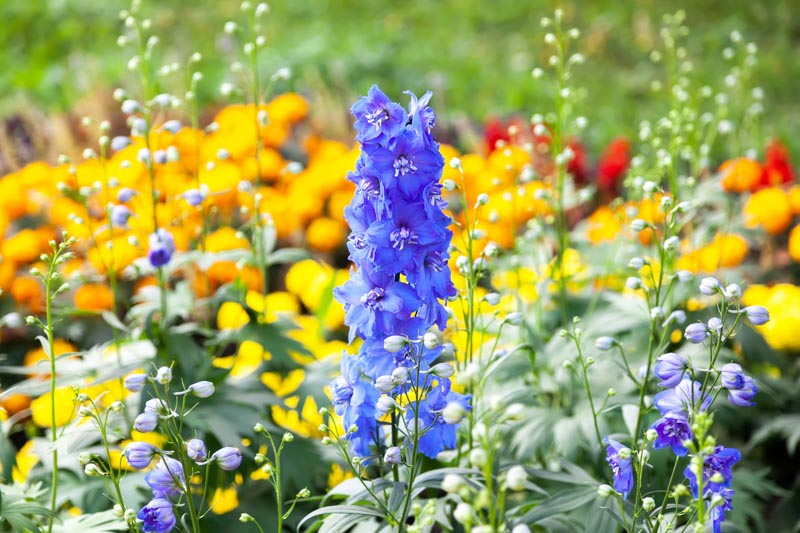Delphiniums can encounter problems affecting their health and appearance. Proper care and preventive measures are essential for maintaining these stunning flowering plants.
While Delphiniums are undoubtedly charming, they’re not without their challenges. These plants are susceptible to various pests, diseases, and environmental stresses. From munching pests like snails and slugs to fungal ailments such as powdery mildew and crown rot, proactive care is essential to keep Delphiniums thriving and flaunting their iconic spires.
Delphinium, commonly known as larkspur, is a classic annual or perennial that graces gardens with tall, elegant spires of colorful blooms. Native to the Northern Hemisphere, it belongs to the buttercup family Ranunculaceae, along with clematis, columbines, and poppies.
A favorite among cottage garden enthusiasts, its flowers range from deep blues and purples to vibrant pinks, whites, and even reds.
Delphiniums display a spectacular array of colors, primarily blues, purples, and whites, with some varieties showcasing pinks and reds. Their palmate leaves form a dense bushy mound at the base, giving rise to their towering flower spikes.
Delphiniums thrive in cooler climates, relishing well-drained soils and full sun to partial shade exposure. Typically associated with cottage garden aesthetics, they bring vertical interest and a splash of color to the garden during their summer bloom.
Besides their ornamental value, Delphiniums also attract pollinators, including bees and butterflies, enhancing the garden’s biodiversity. However, gardeners should exercise caution as all parts of Delphinium are toxic if ingested.

Delphiniums, while breathtakingly beautiful, are not immune to pest and disease issues. Here’s a list of some of the most common problems that target delphiniums, with their associated damages and suggested treatments:
To reduce the chance of these issues, practice good garden hygiene, ensure proper spacing, use resistant varieties when available, and monitor plants regularly for signs of problems.
| Hardiness |
3 - 9 |
|---|---|
| Plant Type | Annuals, Perennials |
| Genus | Delphinium |
| Exposure | Full Sun, Partial Sun |
| Season of Interest |
Summer (Early, Mid, Late) Fall |
| Maintenance | Average |
| Water Needs | Average |
| Soil Type | Chalk, Loam, Sand |
| Soil pH | Acid, Alkaline, Neutral |
| Soil Drainage | Moist but Well-Drained, Well-Drained |
| Characteristics | Cut Flowers, Showy |
| Tolerance | Rabbit, Deer |
| Attracts | Bees, Butterflies, Hummingbirds |
| Landscaping Ideas | Patio And Containers, Beds And Borders |
| Garden Styles | City and Courtyard, Informal and Cottage |
| Hardiness |
3 - 9 |
|---|---|
| Plant Type | Annuals, Perennials |
| Genus | Delphinium |
| Exposure | Full Sun, Partial Sun |
| Season of Interest |
Summer (Early, Mid, Late) Fall |
| Maintenance | Average |
| Water Needs | Average |
| Soil Type | Chalk, Loam, Sand |
| Soil pH | Acid, Alkaline, Neutral |
| Soil Drainage | Moist but Well-Drained, Well-Drained |
| Characteristics | Cut Flowers, Showy |
| Tolerance | Rabbit, Deer |
| Attracts | Bees, Butterflies, Hummingbirds |
| Landscaping Ideas | Patio And Containers, Beds And Borders |
| Garden Styles | City and Courtyard, Informal and Cottage |
Create a membership account to save your garden designs and to view them on any device.
Becoming a contributing member of Gardenia is easy and can be done in just a few minutes. If you provide us with your name, email address and the payment of a modest $25 annual membership fee, you will become a full member, enabling you to design and save up to 25 of your garden design ideas.
Join now and start creating your dream garden!
Create a membership account to save your garden designs and to view them on any device.
Becoming a contributing member of Gardenia is easy and can be done in just a few minutes. If you provide us with your name, email address and the payment of a modest $25 annual membership fee, you will become a full member, enabling you to design and save up to 25 of your garden design ideas.
Join now and start creating your dream garden!